If you want your customers (or potential customers) to sign up, join, or download, you need to guide them with compelling copy. Great calls to action are phrases that motivate a reader to take some kind of action on your website (for example: Join Now, Sign Up, Get Started). The actions called for are numerous and varied and fall into two kinds — hard calls to action and soft calls to action. Continue reading to learn more about making great calls to action.
What Is Call to Action Marketing?
Call to action marketing sells products or services by asking readers to take action on your website that moves them closer to making a sale. Not all calls to action are classified as call to action marketing. Social calls to action occur when you ask a reader to like, share, comment, or follow you on social media. These are social calls to action and are only indirectly related to sales.
CTA Distinguishing Features
A marketing call to action is directly related to the sale. This type of CTA draws the reader one step closer to purchasing your products or services. For example, using them to provide their email address to receive a free e-book is a marketing call to action. Asking them for their email address to receive a weekly newsletter is borderline, as this depends on the kind of information you are providing via your newsletter. For instance:
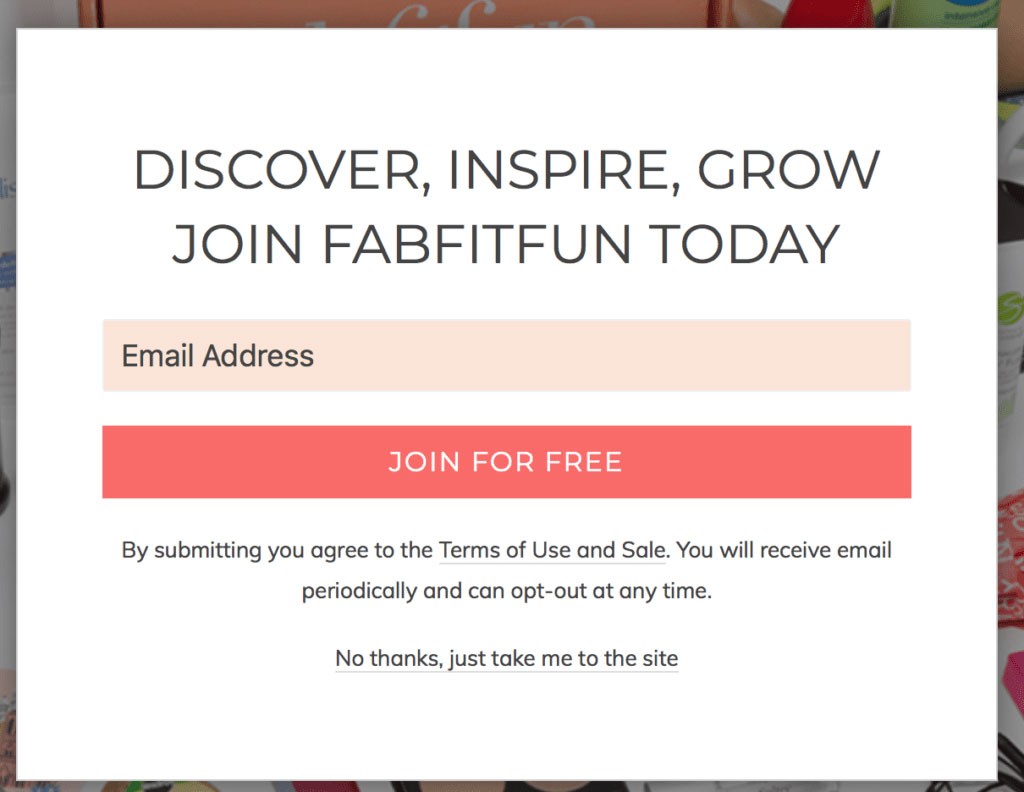
(Image Credit: AdEspresso)
As for social media CTAs, while they do get more eyeballs on your site, improve SEO, and create a fan base, they don’t directly influence the sale itself. Great to have, important to master, but not the kind of CTA being discussed here.
“Hard” versus “Soft” Calls to Action
A hard call to action is an action that takes the customer one step closer to making a purchase, such as downloading an ebook to enter your sales funnel, or clicking on a “buy now” button. For example:
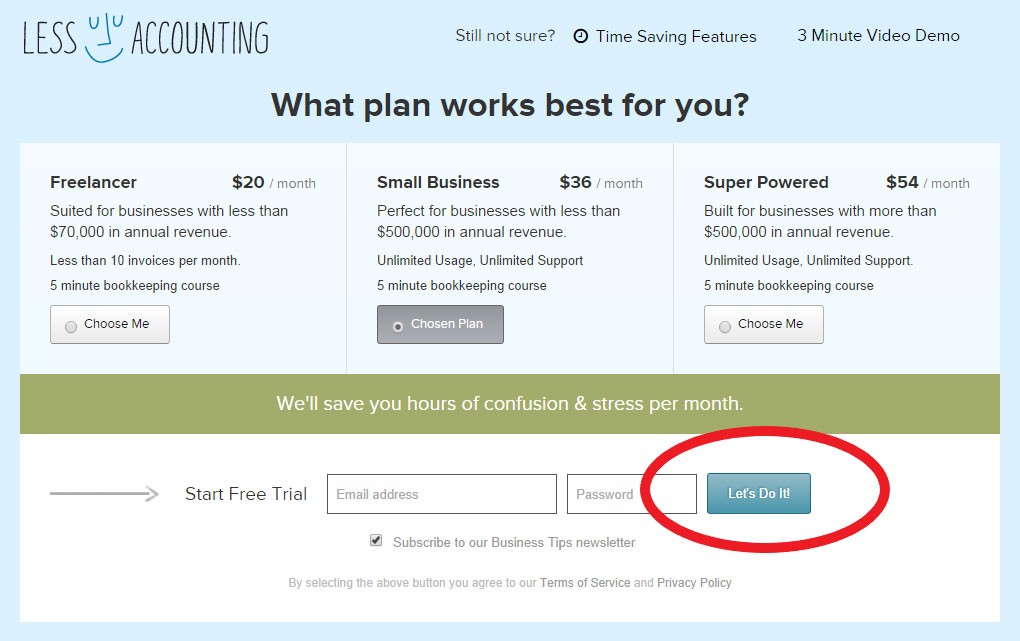
(Image Credit: WordStream)
Soft calls to action are those actions that increase your reach, such as any social media call to action (liking, following, commenting). Soft calls to action are great for expanding your potential customer base but do not actually continue (immediately) to your bottom line. For example:
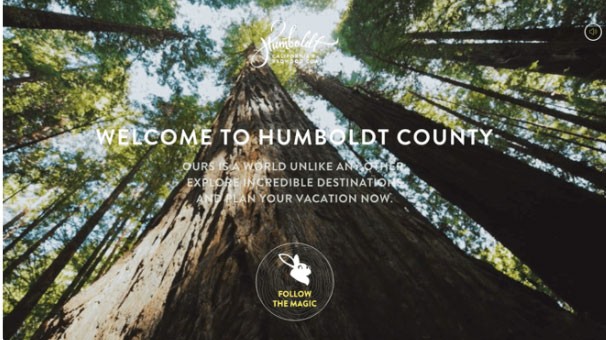
(Image Credit: Hubspot Blog)
What Makes a Call to Action Great?
Any call to action that results in a reader taking the action called for is a great call to action. Calls to action should be S.M.A.R.T. — Specific, Measurable, Achievable, Relevant, and Time-bound.
S: Specific
Never ask for two actions in a single call to action statement. Don’t say, “contact us today or give us a call.”
However, it’s OK to make multiple calls to action within a closing paragraph. So it would be better to say, “Fill out the contact form today” and then, a couple of sentences later, make another call like “We would love to hear from you, give us a call now at …”
Each call to action gives the reader one decision to make, rather than multiple choices.
You Might Also Like
M: Measurable
As with all things related to marketing your products and services, CTAs should be tested, tweaked, and tested some more. Utilize A/B split testing to compare various calls to actions in your website design and copy. If you cannot directly correlate your call to action to a sale, how will you know if it’s great or not?
The measurement piece is the most overlooked portion of marketing, yet is perhaps the most critical part of the entire process. It’s imperative to understand which calls to action are converting to sales, and which ones cause your customers to flee from your site.
A: Achievable
Don’t ask your customers to fill out complicated forms or complete a sequence of actions (remember, specific). Your CTA should be a simple step, such as a “click here” or “fill out your email”, etc. If it is not achievable, it will not be effective.
R: Relevant
The CTA should relate to the information you’re sharing in the copy. If the copy is about growing vegetables, a CTA to give your email for an e-book on beekeeping is not all that relevant. If you sell multiple products, make sure that the CTAs are relevant to the product at hand.
T: Time-bound
The copy on your landing page or blog post should create some sense of urgency. Many people are not interested in a generic offer that could be executed today. So phrases like, “for a limited time,” or “today only” are great when creating a time-bound call to action. Here is a time-bound call to action with a expiration date:
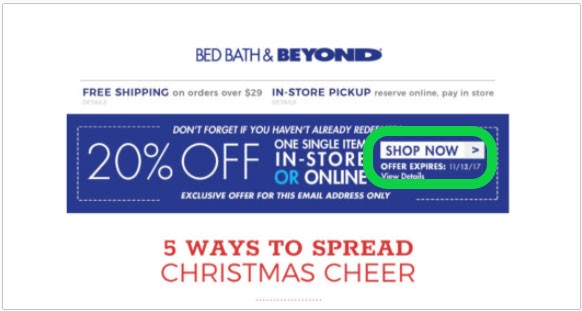
(Image Credit: AdEspresso)
Improve your content marketing + SEO in 60 seconds!
Diib uses the power of big data to help you quickly and easily increase your traffic and rankings. We’ll even let you know if you already deserve to rank higher for certain keywords.
- Easy-to-use automated SEO tool
- Get new content ideas and review existing content
- Checks for content localization
- SEO optimized content
- Built-in benchmarking and competitor analysis
- Over 500,000k global members
Used by over 500k companies and organizations:
Syncs with 
How Do I Make a Call to Action?
To make an effective CTA, the copy leading up to it should first get the reader’s attention, and then provide a story that draws them in from either an intellectual (fact-based) or emotional (empathy-related) perspective. Does the product solve a problem? If so, tell the reader how. Ask multiple questions that have the reader staying “yes” in their mind before making the CTA.
If the copy has successfully pulled the reader in, then the CTA will be very effective. If the reader leaves the page before they even get to your CTA (as noted by the dwell time), then your CTA might be just fine, but your lead-in copy is weak. This is why it is recommended to test, tweak, and test again. There are so many moving pieces involved in CTA marketing that it can be difficult to improve your offers or CTAs without an adequate testing strategy.
Using the S.M.A.R.T. criteria, decide what you wish the reader to do, and then ask them to do that one thing. It is as simple as that. Ask for an email, as for a social share, ask for a comment, ask for a follow, ask for a sale, etc. CTAs can be for anything you want your customer to do.
Examples of Call to Action
Here are some simple call to action words:
- Call
- Visit
- Click
- Buy
- Purchase
- Download
- Join
- Subscribe
- Like
- Comment
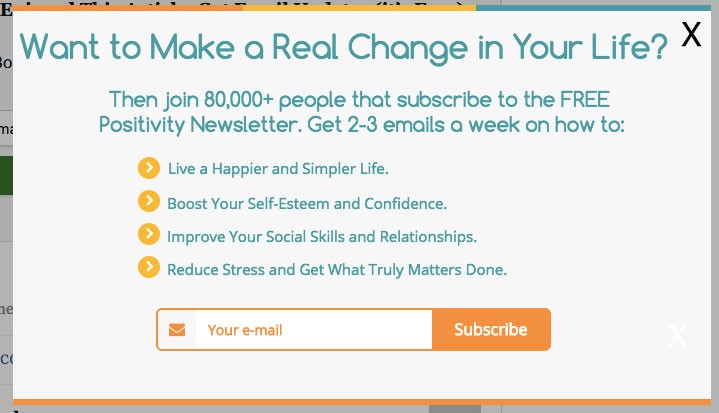
(Image Credit: Wishpond)
As you can see, these are all simple verbs that invite the reader to take an action. That is the very essence of a CTA — asking the reader to do something.
More Call to Action Phrases Examples
These are call to action phrases examples:
- Contact us
- Schedule an appointment
- Join our mailing list
- Sign up for our webinar
- Start a free trial
- Begin your subscription
- Get your free estimate
- Get a quote
- Make an appointment
- Become a VIP
- Follow us on
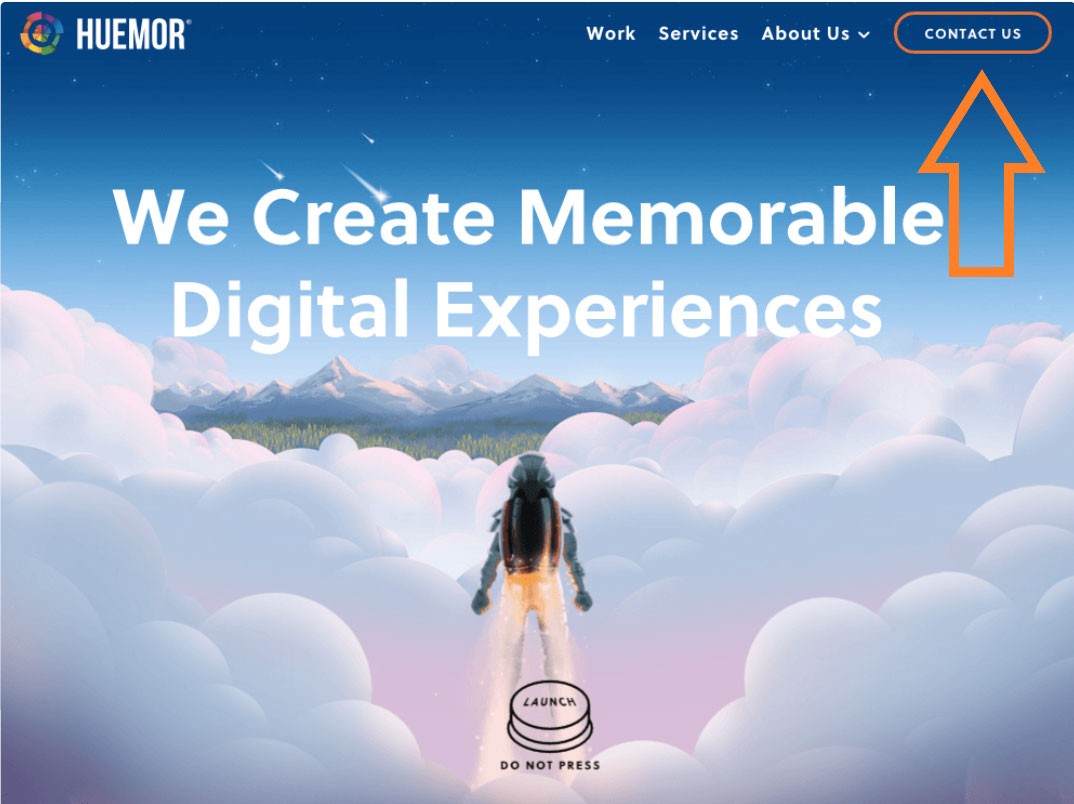
(Image Credit: Hubspot Blog)
Calls to Action Can Be More Than Just Words
It is important to note that calls to action can be much more than just words embedded in your copy. Any fantastic visual elements can be used in conjunction with CTAs to make them more effective.
Arrows
Arrows are an effective way to draw attention to your CTA. They can also have text of their own that directs the reader to take an action, such as “Click Here” or “Fill Out This Form.” Again, as with buttons, grabbing your reader’s attention visually can be very effective. The only way to know for sure is to test, however. The image below shows an arrow going from the word FREE to the call to action:

(Image Credit: Wow Group)
Contact Forms
Make a call to action using a contact form on your website. Offer some incentive for giving you their email address. It could be a free subscription to a newsletter, a discount off their first purchase, or a free ebook.
In this case, the subscription offer would be a soft call to action, while the discount or free e-book would be examples of a hard call to action (assuming that downloading the e-book is the first step of your sales funnel).
Countdown Timers
Remember the “time-bound” criteria above? This is where the countdown timer can be your friend. These countdowns can either be time-based or number-based (such as “Only 10 copies remain”). Countdown timers create a sense of urgency that will compel the reader to take action now rather than leaving your site, perhaps never to return. For instance:
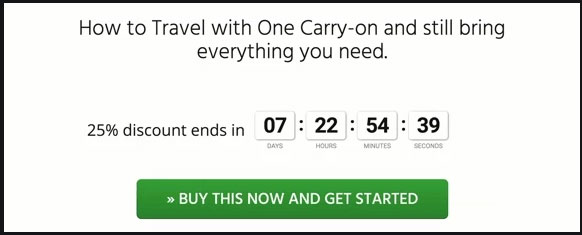
(Image Credit: Thrive Themes)
Buttons
Your call to action could come in the form of a large “Buy now” button that urges your customers to click to buy your product. A bright, colorful button grabs the reader’s eye with a minimum of copy needed. Just make sure you have already provided them with enough reasons to purchase before inserting the button.
Pop-ups, Pop-unders, or Exit Pop-ups
A call to action could come in the form of a pop-up that appears when a reader lands on your site. Examples of call to action pop-ups could be “Spin the Wheel to Receive Your Discount Code” which will be delivered via email. An exit pop-up could contain call to action phrases examples like “Wait, don’t leave, here is the transcript of the video instead” (used when your information is contained in a video), or “Did not find what you are looking for? Search our site here.”
The placement, timing, and messages used in pop-ups should be rigorously tested, as not all consumers respond positively to their use. Some consumers will immediately leave a site if they have to click through a pop-up to get the information they are searching for.
Here is an example of a CTA pop-up:
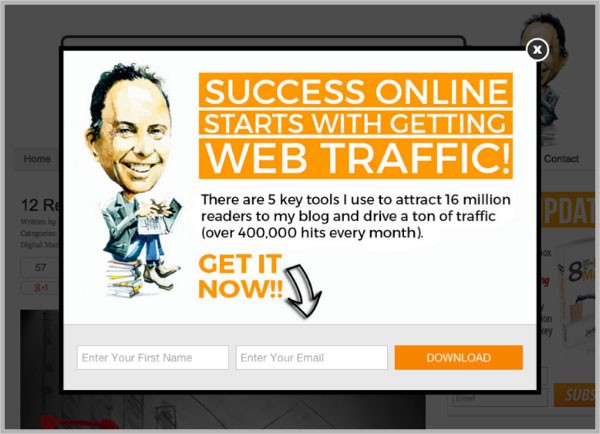
(Image Credit: Jeffbullas’s Blog)
Not All CTA Words or Phrases Are Created Equal
The most powerful CTA words and phrases result in a purchase. In this scenario, “Buy Now” is more powerful than “Click Here to Purchase.” However, the previous statement is pure conjecture without the appropriate testing. This is the perfect example of an A/B split testing scenario.
First, create duplicate web pages. The ONLY thing that should be different between the two pages is your CTA. The rest of the copy, the visual elements, etc. should be identical.
Then, on one page, the button text should read “Buy Now.” On the second page, the button text should read “Click Here to Purchase.” Now it is time to test.
Take a demographically identical population and split it into two groups. Send half of the traffic to the first page, and the second half of the traffic to the second page.
Measure the conversions for each page to see which one is more effective. You have now created your first A/B split test. Continue to run traffic through the page with the highest conversion rate while you develop any other testing you wish to complete.
Why Testing Is So Important
Testing like the scenario outlined above is critical because without data driving your decisions, you might as well be playing a game of pin the tail on the donkey. In order to increase your sales, you need data. The only way to accumulate that data is through testing.
Marketing is an art, not a science. While there are brain-science principles that come into play with marketing, not all customer bases are created equal. Male consumers differ from female consumers. There are generational differences, aka, baby boomers react differently than millennials. If you sell products internationally, consumers in the United States may respond differently than consumers in Europe.
While some entrepreneurs seem to have a sixth sense regarding their customers’ behavior, it is likely that they have great data driving those hunches. They are just not talking about all the time that they spend testing their theories. Because the testing is not obvious, they look like savants.
Successful CTAs Do Not Occur in a Vacuum
Your call to action is the final step in the sales process. It is your close. But without a method to successfully capture your customer’s attention, without a story that thoroughly explains the features and benefits of your product, even the greatest call to action will fail. It is only one step in the entire marketing process. Before crafting your CTA, ask the following questions:
- Who is my customer?
- What is the primary purpose of my call to action? (lead generation, social, purchase, etc.)
- What will compel my customer to act?
- What action do I want my customer to take?
- What are two alternatives I can use to start testing?
Armed with the answers to these questions, you can put together your first test. If neither call to action converts well, consider looking at the other pieces within the overall strategy. Have you hooked the reader’s attention? A high bounce rate could suggest they are not even getting as far as your CTA in the first place.
Is your story or offer compelling? Again, the customer has to want what you are selling before they will make a purchase. Test your calls to actions with different stories to see if that results in more conversions.
Do you have a compelling offer? Product bundles that provide a lot of value when compared to price are a great way to test various calls to action. An offer that promises $1000 worth of products for $99 is sure to get more action than a single $99 product. Again, the call to action itself is just one piece of the puzzle.
We hope that you found this article useful.
If you want to know more interesting about your site health, get personal recommendations and alerts, scan your website by Diib. It only takes 60 seconds.
Some Finals Words
Very few people write the perfect CTA on their first try. There is no straightforward formula for a perfect CTA because every business has a different customer avatar, a different product or service, and a different way of communicating with their customers. What works fantastically for Company A might be disastrous for Company B.
Diib: Your S.M.A.R.T Choice!
Make your CTA S.M.A.R.T. Test, tweak, and test again until you achieve the result you desire. Diib Digital allows you to see minute-by-minute statistics, giving you the unique opportunity to see the effectiveness of your CTAs. Here are some of the features that we’re sure you’ll love:
- Keyword, backlink, and indexing monitoring and tracking tools
- User experience and mobile speed optimization
- Bounce rate monitoring and repair
- Social media integration and performance
- Broken pages where you have backlinks (404 checker)
- Technical SEO monitoring, including CTA tracking
Click here for your free scan or simply call or text 877-606-2070 to speak to one of our Sr. SEO Advisors.
FAQ’s
This is a carefully crafted sentence that tells the reader exactly what action they should and want to take. Words like “buy now” or “continue reading” make ideal CTAs.
When done right, calls to action can help guide the reader through the buying journeyStrategic calls-to-action (CTAs) can help you guide your visitors through the buying and discovery journey. They help to draw the readers’ attention and get them interested in your product or service.
This is a downloadable tool that can help you make an attractive and professional looking CTA. They guide you through the process of choosing an image, the right text and an order button.
First, you replace the #0 with the desired page URL you want to link to. Remove the words “button text” and add your desired text.
The short answer is yes, you can have two different CTA buttons on your Facebook business page.
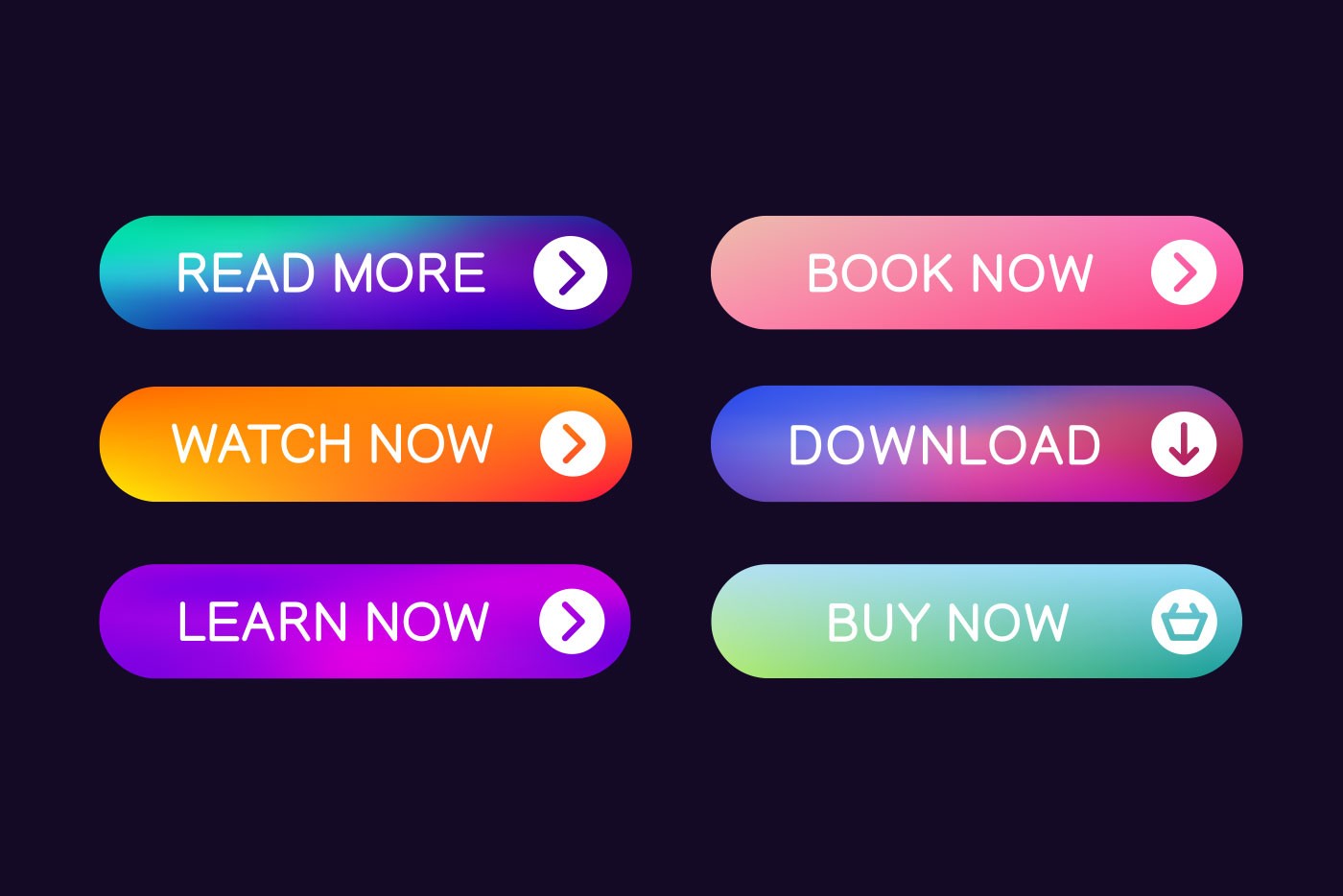



Valentina says:
This was useful, thanks! On my website, I use let’s chat on the contact form.
On social media posts, I always tend to use visit the website, more info on the website but I think I haver to change it a little bit!
retro bowl says:
Great blog, thank you for sharing such new and useful information.
mapquest driving directions says:
Thanks for sharing this information. I really like your blog post very much. You have really shared a informative and interesting blog post with people.
driving directions says:
This is, in my opinion, one of the best posts that you have made. Your work is quite outstanding in both quality and quantity. I am grateful to you for it.
connections game says:
Your article was very impressive to me. It was unexpected information,but after reading it like found it very interesting.
Candy Crush says:
I love this!! I love it.
io games says:
The amount and level of the work done here is very informative